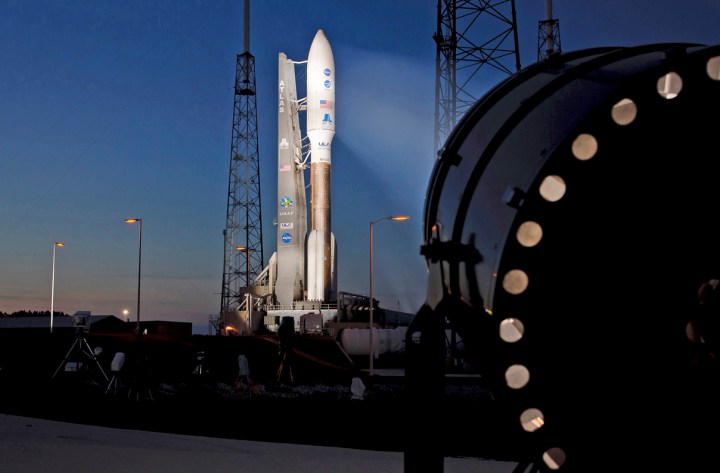Sci-Tech
2011: A year of pushing space frontiers

Last week’s discovery of a potentially-habitable planet, Kepler-22b, might have been the most exciting space-related story of the year. But 2011 has been a big one for astronomical discoveries. REBECCA DAVIS takes a look at some of the hits of the year.
They found a whole lot of planets which might sustain life
21 February: It was announced that astronomers using the Kepler telescope had identified at least 54 planets which appeared to be a similar in size to Earth and at habitable distances from their suns. This was the prelude to December’s announcement about Kepler 22b.
Read more:
- Life on other planets, in The Telegraph.
Juno: Not just an overrated indie film
5 August: Nasa launched the Juno space probe to begin a journey to the largest planet in our solar system, Jupiter. It would have covered the distance from Earth to the moon in less than a day, but then take a further five years to reach Jupiter. They are hoping it will send back vital information about Jupiter’s origins and structures, which may help cast light on the origins of our own planet.
Read more:
- NASA’ Juno spacecraft launches to Jupiter, on NASA website.
A planet made of diamonds, doll!
25 August: Astronomers in Melbourne announce a planet that seems to be made largely of diamond. They describe it as “a massive diamond orbiting a neutron star”. Each “day” on this planet lasts only two hours and 10 minutes. It has slightly more mass than Jupiter, but is 20 times as dense. And unfortunately for De Beers, it’s 4,000 light years away.
Read more:
- Astronomers discover planet made of diamond, on Reuters.
Star Wars was right about Tatooine (and everything else)
15 September: Nasa finds a world with a double sunset. The technical term for this kind of planet is “circumbinary”, because it orbits two stars. George Lucas “predicted” its existence more than 30 years ago, called it Tatooine and launched the Star Wars franchise.
Read more:
- NASA’S Kepler Discovery Confirms First Planet Orbiting Two Stars, on NASA website.
Bill Clinton had to give back a moon rock
22 September: A missing moon rock was found in a box of Bill Clinton’s stuff in Little Rock, Arkansas. The rock was brought back by the 1972 Apollo 17 mission and went missing last year. Aides said they had no idea how or when it made its way into Clinton’s possession. In early December Nasa admitted that “517 loaned astromaterials have been lost or stolen between 1970 and June 2010”. These included moon soil, meteorites and cosmic dust. Perhaps they want to search Bill Clinton’s office again.
Read more:
- Missing moon rock found among Clinton papers, in The Telegraph;
- Hundreds of NASA moon rocks missing, on Discovery News.
We were all almost crushed to death by falling satellites
24 September and 22 October: It was the year of falling satellites. The biggest of these was the Upper Atmosphere Research Satellite (UARS), a Nasa observatory deployed in 1991 to study the atmosphere. It crash-landed on 24 September in a flurry of media attention due to Nasa warning it might strike inhabited areas. As it turned out, it came down in a remote part of the Pacific Ocean. Similarly, a German spacecraft called the Roentgen Satellite came down in late October, with about 1.6tons of wreckage predicted to make it back. As it turned out, the Roentgen also splashed peacefully into the ocean.
Read more:
- German Rosat spacecraft makes uncontrolled re-entry, on BBC;
- Upper Atmosphere Research Satellite, on Wikipedia.
Mars, here we come
27 November: Nasa launched the biggest and boldest mission to another planet, when the Mars Curiosity rover blasted off from the Kennedy Space Centre. If all goes well, Curiosity will reach Mars next summer and spend two years examining the planet for life. It is decked out with huge cameras and drills. Programme director Doug McCuiston said of the mission: “Science fiction is now science fact”. Fewer than half the previous Mars missions succeeded.
Read more:
- Mars Curiosity rover launch marks boldest ever interplanetary mission, on the Guardian.
Kepler-22b could change everything
5 December: The Kepler space telescope verified the existence of the first planet in the “Goldilocks Zone” (where liquid could exist on its surface throughout its orbit). Kepler-22b is about 2.4 times the radius of Earth and takes 290 days to orbit around its sun. Unfortunately for anyone getting excited about moving there, it is 600 light years away.
Read more:
- Kepler confirms first planet in habitable zone, on NASA website.
The blackest black holes ever
5 December: The journal Nature announced the discovery of two new black holes, the biggest ever discovered, about 330-million light years away. The smaller has the mass of 9.7-billion suns and the bigger that of 21-billion suns. We still know almost nothing about black holes, other than that they once were massive stars who have subsequently collapsed in on themselves, a bit like Mel Gibson. To quote The Guardian: “Black holes are a one-way ticket to mystery, a place where known (laws of) physics seem to break down and the space we are all familiar with becomes supremely strange”.
Read more:
- Supermassive black holes are largest ever discovered, in the Guardian.
Voyager 1 is boldly going where nothing has gone before
7 December: Nasa announced that its Voyager 1 spacecraft, launched in 1977, was on the verge of becoming the first man-made object to leave our Solar System. Reports on this read like excerpts from a Phillip Pullman or CS Lewis novel, with Nasa describing the stretch of space between the Solar System and deepest darkest space as “cosmic purgatory”, also known as the “doldrums” because it’s a place where the solar winds no longer blow. Voyager 1 has enough fuel and power to keep truckin’ till 2020, it’s hoped.
Read more:
- Nasa’s Voyager 1 in ‘cosmic purgatory’ on verge of entering Milky Way, in the Telegraph.
DM
Photo: REUTERS





 Become an Insider
Become an Insider